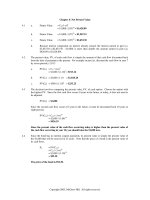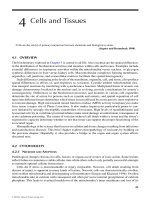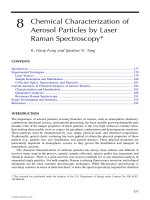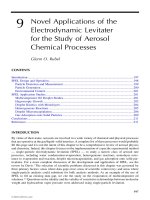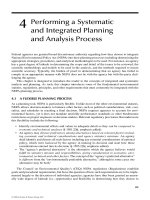INTERFACIAL APPLICATIONS IN ENVIRONMENTAL ENGINEERING - CHAPTER 4 pdf
Bạn đang xem bản rút gọn của tài liệu. Xem và tải ngay bản đầy đủ của tài liệu tại đây (180.77 KB, 14 trang )
4
Chemistry of Sulfur Oxides on
Transition Metal Surfaces
XI LIN and BERNHARDT L. TROUT Massachusetts Institute of
Technology, Cambridge, Massachusetts, U.S.A.
I. INTRODUCTION
Transition metals are currently the most widely used heterogeneous catalysts in
industry. In this article, we shall focus our attention primarily on the automobile
engine-out exhaust emission catalysts for environmental concerns. In order to
meet automobile emission control requirements in the United States, so-called
three-way catalysts, consisting of Rh, Pt, and Pd, were selected to simultaneously
convert CO, hydrocarbons, and NOx to CO
2
,H
2
O, and N
2
[1]. In this conversion
process, both oxidation and reduction reactions take place on the same three-way
catalyst surfaces. Therefore, only a narrow range of air-to-fuel (A/F) ratios
around the stoichiometric point should be taken as the operating “window” of
the catalytic conversion. However, it is certainly desirable to have a wider A/F
range with a better rate of conversion of CO, hydrocarbons, and NOx.
Lean-burning NOx-trapping catalysts were designed for this purpose. The idea
is to separate the competing oxidation and reduction reactions by time, via period-
ically alternating the A/F ratio between lean (high A/F ratio) and stoichiometric
(A/F ratio ϳ 14.6) conditions in the combustion chamber. Under lean conditions,
both CO and hydrocarbons can be efficiently oxidized to CO
2
and H
2
O, while
NOx will be oxidized to the unfavorable chemical NO
2
. At the same time, by
introducing NOx-trapping materials such as BaO, NO
2
is trapped on the catalyst
within this lean cycle. When the stoichiometric cycle is alternatively switched
on, the trapped NO
2
is reversibly released from the BaO surface and further re-
duced to N
2
. However, this novel lean-burn NOx-trap catalysis process has con-
siderable practical problems due to serious sulfur poisoning issues (described
below).
Before getting to the sulfur poisoning problem for the lean-burn NOx-trap
catalyst, let us examine how the traditional three-way catalyst could get over this
TM
Copyright n 2003 by Marcel Dekker, Inc. All Rights Reserved.
56 Lin and Trout
sulfur problem. Ever since the early 1980s, when three-way catalysts were first
introduced, a substantial amount of research has been carried out to understand
the interaction of SO
2
with the catalysts, due to the concern that SO
2
might be
catalytically oxidized to sulfuric acid and released to the environment together
with the automobile exhaust. Note that a typical concentration of 0.03 wt% (or
ϳ200 mg L
Ϫ1
) sulfur is present in unleaded regular gasoline, which produces
about 20 ppm of SO
2
in the engine-out exhaust gas [1]. However, it is quite
surprising that little sulfuric acid was actually generated by these three-way cata-
lysts. It was thought that the use of Rh might help to lower the activity of the
three-way catalysts for SO
2
oxidation, compared to a pure oxidation catalyst [2].
More importantly, the stoichiometric air-to-fuel ratio helped to suppress the SO
2
oxidation.
Under lean-burning conditions, however, full oxidation of SO
2
to SO
3
or sulfu-
ric acid is feasible when excess oxygen exists on the three-way catalysts. Both
SO
3
and sulfuric acid can severely damage NOx-trapping materials, such as BaO.
This poisoning process is very difficult to reverse and therefore inhibits utilization
of the lean-burning NOx-trapping catalysts. Thus, a detailed understanding of
the general sulfur poisoning effect on transition metals and metal oxides is neces-
sary for the development of next-generation automobile exhaust emission cata-
lysts. It was proposed that sulfur poisoning will not be serious if one manages
to block the oxidation channel of SO
2
to SO
3
on these catalyst surfaces under
lean conditions.
Although the oxidation of SO
2
to SO
3
is not significant under stoichiometric
conditions, early research did show that the presence of SO
2
in engine-out exhaust
affected the reactivity of the three-way catalysts. It was demonstrated that by
increasing the sulfur concentration in gasoline from zero to 0.03 wt%, one ob-
served lowering of the conversion efficiency of CO, hydrocarbons, and NOx [3].
The effect of sulfur on the activity of three-way catalysts was found to be more
pronounced under rich conditions. This was attributed to a larger coverage of
catalytic sites by atomic sulfur under rich conditions than under dynamic condi-
tions around the stoichiometric point. Laboratory durability studies also indicated
a faster drop in activity with time with sulfur-containing (0.03 wt%) fuel, com-
pared to the sulfur-free fuel [3,4].
Moreover, SO
2
has been found to influence the selectivity of three-way cata-
lysts. The importance of sulfur chemistry on transition metal surfaces was re-
cently highlighted in a series of extensive experimental studies geared to under-
standing how SO
2
poisons the oxidation of CO and propene but promotes the
oxidation of alkanes, such as propane [5–7].
It is believed that the sulfur poisoning effect on transition metals is due mainly
to the high reactivity of sulfur with transition metals. However, at this time, few
details of the elementary reactions involving SO
2
are known. This is because
TM
Copyright n 2003 by Marcel Dekker, Inc. All Rights Reserved.
Sulfur Oxides on Transition Metal Surfaces 57
these processes are complex and frequently made even more complicated by the
interaction of reactants and products with coadsorbed species.
First-principles computational research has become an efficient and accurate
technique, complementary to experimental work in terms of determining both
the static and the dynamic properties of molecules on extended transition metal
surfaces. This approach was benefited mainly by the rapid progress of density-
functional theory (DFT) [8,9] and pseudo-potential [10] techniques associated
with the fast increase of computational power in the past couple of decades.
The static properties computed from first principles consist of a variety of elec-
tronic and geometrical structures, including adsorbate configurations, surface
reconstruction, electronic spin configurations, and adiabatic potential energy
surfaces. The dynamic processes comprise sticking, diffusion, desorption, and,
most important and interesting, surface chemical reactions. First-principles
molecular dynamics on metal surfaces are still under development, but rough
estimates of entropic effects may be obtained based on static adiabatic potential
energy surfaces using the harmonic approximation and transition state theory
[11].
Rather generally, theoretical studies for the sulfur poisoning effect on transi-
tion metal surfaces indicated that the perturbations caused by sulfur-containing
molecules on the metal electronic structure reduce the ability of these metals to
adsorb CO and dissociate hydrocarbons [12–14]. Moreover, it was shown that
these induced electronic perturbations could have a long-range character.
II. STATIC INTERACTIONS: EQUILIBRIUM
POSITIONS AND ADIABATIC POTENTIAL
ENERGY SURFACE
The major goal of research on the static properties of chemical systems is to
obtain the adiabatic potential energy surface of the groundstate, which includes
the following:
1. Equilibrium atomic positions, such as bond lengths, bond angles, and tor-
sion angles, among both the adsorbates and possible substrate surface reconstruc-
tion. In surface science experiments, the atomic vibrational modes with certain
underlying symmetries are the main observables and have been extensively inves-
tigated through high-resolution electron energy loss spectroscopy (HREELS),
surface-extended X-ray absorption fine structure (SEXAFS), and near-edge X-
ray absorption fine structure (NEXAFS) techniques. Referring to the gap-phased
isolated adsorbate molecules, UV photoelectron spectroscopy (UPS), angle-
resolved UPS (ARUPS), and X-ray photoelectron spectroscopy (XPS) can pro-
vide hints for identifying adsorbate species. However, the classic experimental
TM
Copyright n 2003 by Marcel Dekker, Inc. All Rights Reserved.
58 Lin and Trout
surface structure determination approach, low-energy electron diffraction
(LEED), does not seem to be useful, because adsorbed sulfur-containing mole-
cules, such as SO
2
, do not exhibit long-range order. Even if they do, they would
rapidly be destroyed upon an electron beam.
2. The static properties also contain the electronic spin configurations, since
many of the transition metals and their derivatives are ferromagnetic crystals. It
is known that spin plays an essential role in the groundstate properties of small
transition metal clusters [15,16]. This spin effect might not be particularly impor-
tant in the case of SO
2
, compared, for example, with NO [17], since the adsorbate
molecule is spin-pared. To our knowledge, no experimental work, such as elec-
tron paramagnetic resonance (EPR), has been performed especially for the pur-
pose of studying sulfur oxides on transition metal clusters.
3. Thermodynamic properties are important by themselves, as well as serv-
ing as the basis for many dynamic approaches, such as transition state theory.
Temperature-programmed desorption (TPD) is widely used, but the accuracy in
many cases is only qualitative [16]. A rather wide binding energy range from
100 to 150 kJ/mol is estimated from TPD data for SO
2
on the Pt(111) surface
[18]. A single crystal adsorption calorimetry study [19] on SO
2
has not been
reported up to this time.
A. Gas-Phase Sulfur Oxides
Isolated gas-phase SO is linear, possessing the C
∞v
point group symmetry. The
intramolecular SE O bond length is 1.48 A
˚
. The spin-polarized electronic con-
figurations around the highest occupied molecular orbital (HOMO) and the lowest
unoccupied molecular orbital (LUMO) are shown in Figure 1a. From the frontier
orbital point of view [20], these single-particle orbitals should be considered the
most active ones in most kinds of chemical reactions, including surface reac-
tions [21].
Gas-phase SO
2
has an intramolecular SE O bond length of 1.43 A
˚
and an
OE SE O angle of 120°. As shown in Figure 1b, both the HOMO and LUMO
are localized mainly on the sulfur atom, which suggests that bonding of SO
2
via
the sulfur atom to the transition metal surfaces should be expected. Note that a
᭤
FIG. 1 Groundstate electronic configurations. Spheres represent s-type and lobes repre-
sents p-type atomic orbitals. For the p-type atomic orbitals, white and dark regions stand
for different phases of the orbitals, while bigger lobes indicate larger participation in the
corresponding molecular orbitals. (a) SO (triplet, C
∞v
). Diagram on the left/right shows
the majority/minority spin configurations. The HOMO is the Π bonding in the majority
spin and the LUMO is the Π antibonding in the minority spin. (b) SO
2
(singlet, C
2v
). (c)
SO
3
(singlet, C
3v
).
TM
Copyright n 2003 by Marcel Dekker, Inc. All Rights Reserved.
(a)
(b)
(c)
TM
Copyright n 2003 by Marcel Dekker, Inc. All Rights Reserved.
60 Lin and Trout
FIG. 2 Free energy/temperature plot of gas-phase SO
2
and SO
3
. (From Ref. 22.)
larger overlap of the p-orbitals between the sulfur and oxygen atoms is expected
for the HOMO, compared to the LUMO, due to the in-plane OE SE O bond
angle.
Gas-phase SO
3
has the largest number of oxygen atoms among all neutral
sulfur oxides. It has a planar structure and possesses a C
3v
symmetry. The intra-
molecular SE O bond length is 1.43 A
˚
, almost the same as that in the gas-phase
SO
2
molecule. The OE SE O bond angles are 120°. The free energy versus tem-
perature [22] is plotted in Figure 2 to show the thermodynamic stability of gas-
phase SO
2
versus SO
3
. Note that two curves cross at ϳ1100 K, which indicates
that SO
3
is more stable than SO
2
under a typical engine-out exhaust temperature
ϳ600 K. Therefore the experimentally observed SO
2
in engine-out exhaust gas
is due to kinetic limitations under lean conditions. We notice that the LUMO
level of SO
3
possesses the same phases of the p-orbitals from three oxygen atoms
and the opposite phase of the p-orbital from the central sulfur atom. Therefore,
one should expect a bent molecular structure (sulfur atom protruding out of the
plane containing the three oxygen atoms) when the LUMO of SO
3
accepts elec-
trons from donors of the same phase.
B. SO
2
on Pt(111)
SO
2
plays one of the most essential roles among all the sulfur oxides (SO
x
, x ϭ
0, 1, 2, 3, 4), since it is readily formed by burning natural sulfur-containing mate-
TM
Copyright n 2003 by Marcel Dekker, Inc. All Rights Reserved.
Sulfur Oxides on Transition Metal Surfaces 61
rials or by roasting metal sulfides in air. The most important intermediate process
in the manufacture of sulfuric acid is the oxidation of SO
2
to SO
3
in the presence
of transition metal catalysts, such as platinum, because platinum is a very effec-
tive catalyst for SO
x
oxidation. Thus the interaction of SO
2
on Pt(111) has re-
ceived the widest attention of all of the transitions metals.
It is generally agreed that the SO
2
molecule adsorbs intact on the Pt(111)
surface at low temperatures, typically 100–160 K. Through XPS, UPS, TPD, and
HREELS, Sun et al. [23] found that the binding of the SO
2
molecule was through
an η
2
-S,O structure, while the SO
2
molecular plane was essentially perpendicular
to the Pt(111) surface. Their further simple frontier molecular orbital analysis
suggested a preferred configuration with the sulfur atom on a bridge site and one
oxygen atom on a top site. More recently, Polcik et al. [24] claimed to have
found a new flat-lying configuration of SO
2
on the Pt(111) surface at 150 K in
their combined XPS and NEXAFS study and pointed out that this new flat-lying
configuration was invisible in the HREELS experiments by Sun et al. [23]. But
Polcik et al. did not give any detailed structural information for this new flat-
lying configuration. Sellers and Shustorovich employed the empirical bond order
conservation–Morse potential method [25,26] and concluded that the most stable
configurations involved dicoordination binding through both η
2
-S,O and η
2
-O,O
structures on the Pt(111) surface but no flat-lying configurations.
Our first-principles DFT calculations confirmed both of (and only) the two
most stable structures found by Sun et al. [23] and Polcik et al. [24] (one perpen-
dicular and the other parallel to the Pt(111) surface) at low temperatures. We did
not find any stable η
2
-O,O structure. Detailed results will be published separately.
C. SO
2
on Other Transition Metal Surfaces
Similar to the interaction of SO
2
on the Pt(111) surface, SO
2
follows either spon-
taneous or thermally activated decomposition on all of the transition metals ex-
cept Ag, on which SO
2
adsorbs and desorbs only molecularly [27]. Temperature-
programmed desorption, UPS, and XPS studies by Outka and Madix on Ag(110)
showed that three cleanly distinct phases exist, depending on the temperature:
(1) multilayer SO
2
under 120 K, (2) dual-layer SO
2
between 140 and 175 K, and
(3) monolayer SO
2
between 175 and 275 K. The clean Ag(110) surface can be
restored at temperatures greater than 275 K, which indicates a complete molecular
desorption of SO
2
[27].
Molecular SO
2
was detected intact on Pd(100) at temperatures below 120 K
in a TPD and EELS study by Burke and Madix [28]. When heated up to 135 K,
multilayer SO
2
desorbed and left a single layer of SO
2
on the Pd(100) surface.
The monolayer of SO
2
left consequentially decomposed at 240 K, forming chemi-
sorbed SO, which led to atomic sulfur and oxygen on the surface at even higher
temperatures. Similarly, in a combined TPD, XPS, and ARUPS study [29], Zeb-
TM
Copyright n 2003 by Marcel Dekker, Inc. All Rights Reserved.
62 Lin and Trout
isch et al. showed that the SO
2
multilayer desorbed at about 130 K, and the
remaining SO
2
monolayers desorbed at 360 K on a Ni(110) surface. The heating
left a large number of sulfur atoms on the surface. An NEXAFS study indicated
that SO
2
adsorption at 170 K is partly dissociative on Ni(110), Ni(111), and
Ni(100) surfaces [30,31]. Partial dissociation of adsorbed SO
2
also occurs on
Cu(100) and Cu(111) surfaces at 180 K, although more detailed measurements
indicated much less dissociation on Cu(111) than on Cu(100) [32].
As for the geometric structure of the chemisorbed SO
2
, it was suggested that
the molecular plane of chemisorbed SO
2
aligned perpendicular to the closed-
packed rows, as is the case on the Pt(111) surface. Detailed measurements also
suggested that the SO
2
bonds to the surface through the S atom. The C
2
axis was
shown to be perpendicular to the surface via measurements such as on Ag(110)
in an NEXAFS study by Solomon et al. [33], or the C
2
axis could also be tilted
within the SO
2
molecular plane on Pd(100) [28] and Cu(111) [34], similar to that
on Pt(111) as described earlier. This tilted axis was attributed to the additional
O–substrate bonding interaction, which might lead to the dissociation of molecu-
lar SO
2
.
However, an XAFS study of low-coverage SO
2
on Ni(110), Ni(111), and
Ni(100) surfaces [30,31] suggested that SO
2
species orient themselves with mo-
lecular planes approximately parallel to the surface, which is also similar to the
second most stable structure on Pt(111), as discussed earlier. Therefore, one may
conclude that there are in general two stable SO
2
species present on various transi-
tion metal surfaces, one perpendicular and one parallel to the surface. Depending
on the symmetry restrictions in experimental techniques, one may not always be
able to observe both of the species.
Unfortunately, little knowledge has been obtained directly from experiments
on the surface adsorption site. Although in general it might be quite misleading,
making use of the surface-cluster analogy suggested an atop site of SO
2
on the
Ag(100) surface [33], and a fourfold hollow site of SO
2
with an oxygen atom
close to a bridge site was suggested on the Pd(100) surface [28]. It is noted that
a quite surprising location of SO
2
has been suggested in which the sulfur atom
is equally distributed between the long- and short-bridge sites on Ni(100),
Ni(111), and Ni(110) surfaces [30,31].
One recent NEXAFS and SEXAFS study by Polcik et al. demonstrated the
presence of a SO
2
-induced surface reconstruction of Cu(111) at 170 K, on which
the sulfur atom of the molecular SO
2
is located at a hollow site on a locally
pseudo-(100) reconstructed surface [34]. However, a later study by Jackson et
al. using chemical-shift normal-incidence X-ray standing waves (CS-NIXSW)
on the identical system seemed to disagree with the proposed local pseudo-(100)
reconstruction [35]. A very recent scanning tunneling microscopy (STM) study
by Driver and Woodruff further demonstrated that the kind of pseudo-(100) re-
TM
Copyright n 2003 by Marcel Dekker, Inc. All Rights Reserved.
Sulfur Oxides on Transition Metal Surfaces 63
constructions on Cu(111) can be induced by atomic sulfur, formed by dissociated
methanethiolate under an electron beam [36].
Recently Rodriguez et al. performed a DFT calculation to examine the adsorp-
tion of SO
2
on Cu(100) and showed an increasing bonding energy in the order
of η
1
-S Ͻ η
2
-S,O Ͻ η
2
-O,O Ͻ η
3
-S,O,O. To make comparison with experiments,
Rodriguez et al. further proposed η
2
-O,O or η
2
-S,O to be the most stable configu-
ration under large coverage limit, by assuming the large surface SO
2
coverage
made the η
3
-S,O,O binding mode impossible [37].
D. SO on Transition Metals
Dissociation of SO
2
, resulting in SO species, has been experimentally observed
on Pt(111) [23,24], Pd(100) [28], Cu(100) [32], Cu(111) [32], Ni(100) [30,31],
Ni(111) [30,31], and Ni(110) [29] surfaces, as discussed earlier. Our DFT studies
suggested that the thermodissociation of SO
2
on Pt(111) to SO was energetically
unfavorable at low temperatures. Further dissociation of molecular SO to S and
O atoms would cost even more energy, therefore being even less favorable.
The dissociation of SO
2
has been observed at higher temperatures, for exam-
ple, at 240–270 K on Pd(100) [28]. A similar dissociation temperature of ϳ300
KofSO
2
on Pt(111) and all the other transition metal surfaces is also reported.
The chemisorbed SO thus formed, sequentially recombined with other surface
adsorbates to form higher oxidized species, such as SO
4
, at the same tempera-
ture [23].
SO
2
adsorption on Cu(100) is partly dissociative, even at about 180 K. An
SEXAFS study suggested that the sulfur atom was located at a fourfold hollow
site and that the oxygen atom was located at a near-bridge site [32]. The recent
DFT calculations by Rodriguez et al. showed a cost or ϳ67–111 kJ/mol in energy
for this dissociation process [37]. This is rather misleading, however, since a
meaningful comparison must be done by allowing the separation of the dissoci-
ated SO and O species instead of by constraining them in one small supercell.
E. SO
3
on Transition Metals
Our DFT calculations showed that this oxidation reaction is energetically favor-
able at low temperatures on the Pt(111) surface. In experiments, following the
dissociation of chemisorbed SO
2
on transition metal surfaces, such as Pd(100),
Cu(100), and Ni(110) at ϳ170 K, SO
3
is formed upon adsorption as well as after
heating the SO
2
layers to room temperature. On Ag(110), however, SO
2
can be
oxidized to SO
3
only when preadsorbed oxygen is available.
An NEXAFS and CS-NIXSW study of SO
3
on Cu(111) shows that the C
3v
axis of the adsorbed SO
3
is perpendicular to the surface, located at atop sites,
TM
Copyright n 2003 by Marcel Dekker, Inc. All Rights Reserved.
64 Lin and Trout
with the sulfur atom pointing out of the plane formed by the three oxygen atoms,
away from the surface [35].
The DFT calculation by Rodriguez et al. showed that the bonding of SO
3
to
Cu(100) was through an η
3
-O,O,O configuration, with the C
3v
axis perpendicular
to the surface. They again proposed η
2
-S,O as the most stable binding configura-
tion in the high SO
3
surface coverage limit [37].
F. SO
4
on Transition Metals
The oxidation of chemisorbed SO
2
to SO
4
species has been observed on essen-
tially all the transition metal surfaces studied. In addition to the oxidation of SO
2
to SO
3
, our DFT calculations showed that this oxidation reaction, i.e., from SO
3
to SO
4
, is also energetically favorable at low temperatures on the Pt(111) sur-
face.
SO
4
species have been observed via spectroscopic methods to be present on
transitional metal surfaces, such as Pt(111) and Pd(100), at 300 K [23]. It is
believed that the dissociation of SO
2
must occur first in order to provide chemi-
sorbed atomic oxygen on the surface, if no additional gas-phase oxygen was
supplied. These SO
4
species on Pt(111) decompose when the temperature is
above 418 K without increasing the amount of atomic sulfur on the surface [24].
Under lean conditions, when oxygen is preadsorbed on Pt(111), chemisorbed
SO
2
readily reacts with preadsorbed oxygen to form SO
4
, which has been indi-
cated as the key surface species responsible for SO
2
-promoted catalytic oxidation
of alkanes [5,6]. When CO or propene are coadsorbed, the SO
2
overlayers would
be efficiently reduced to form atomic sulfur. The latter contributed to the poison-
ing of the oxidation of CO and propene in the presence of SO
2
under rich condi-
tions. At ϳ550 K, adsorbed SO
4
is identified as the precursor to SO
3
desorp-
tion [6].
Similar to the SO
2
-induced Cu(111) reconstruction described earlier, it was
observed in an STM study by Broekmann et al. that the topmost layer of Cu(111)
was reconstructed by sulfate when the Cu(111) surface was exposed to a dilute
sulfuric acid solution [38].
G. Modified Transition Metals Toward Designed
Reactivity
Beyond the simple single-crystal transition metal surfaces, possible modifications
on the activity of the transition metals toward reactions involving sulfur oxides
consist of:
1. Bimetallic or multimetallic alloys and metal oxides. These alloys can be
mixed layer by layer or mixed within layers and repeated through whole crystals.
It is shown that tin, acting as a site blocker, forms a well-defined and stable alloy
TM
Copyright n 2003 by Marcel Dekker, Inc. All Rights Reserved.
Sulfur Oxides on Transition Metal Surfaces 65
with Pt(111). A much better chemical resistance of this Sn/Pt alloy is demon-
strated toward SO
2
,S
2
,H
2
S, and thiophene, compared to pure Sn and Pt [39].
Bimetallic Pd/Rh [40], Pd/Ni, and Pd/Mn systems demonstrated good catalytic
activity and less sensitivity to the presence of sulfur-containing molecules than
pure Pd. A general trend was obtained concerning the metal reactivity toward
oxidation of SO
2
, which increases in the following order: Pt ϳ Rh Ͻ Ru Ͻ Mo Ͻ
Cs/Mo Ͻ Cs [41]. Although having served as inert supports for metal catalysts
for a long time, metal oxides can actually become part of the active sites of the
catalysts. Experiments on the adsorption of S
2
,H
2
S, CH
3
SH, and thiophene on
a series of oxides, Al
2
O
3
, ZnO, Cu
2
O, MoO
2
,Cr
2
O
3
, and CeO
2
, showed that the
sulfur atoms formed by the dissociation of these molecules interacted mainly
with the metal centers of the surface, while SO
2
reacts preferentially with the
oxygen centers to form SO
3
and SO
4
species [42]. Theoretical calculations sug-
gest that a larger bandgap in the oxide can better prevent sulfur poisoning from
the metal oxide, due to the more stable valence band and the greater difficulty
in moving the valence electrons. However, this oxide support does not really
help prevent the supported metals from being poisoned by sulfur. Detailed studies
of various transition metals on various metal oxide supports suggested that the
sulfur-containing molecules always prefer to interact with the supported transition
metals.
2. Finite-size metal particles instead of extended 2-D surfaces on supports.
The dependence of site of reactivity, such as for CO chemisorption on Cu(100)
[43] and dissociation on alumina-supported Rh [44], has been known for quite
a long time. Our DFT study indicated that a special tetrahedron Pt-10 cluster
possessed a rather low activity toward atomic sulfur chemisorption [16].
3. Stepped surfaces. First-principles DFT calculations showed that the
atomic oxygens are attracted to step edges on Pt(111) [45]. In ammonia synthesis
catalysis, it was shown that the stepped Ru(0001) surfaces lowered the activation
energy of N
2
dissociation by 1.5 eV. It is further claimed that such a low barrier
at the step was due to a combination of electronic and geometric effects [46].
4. Crystals under external fields, such as stress, electric, or magnetic fields.
It was shown by a DFT study that strained metal surfaces have significantly
different chemical properties from those of unstrained surfaces. The surface reac-
tivity can be increased by expanding the lattice, which was followed by a con-
current upward shift of the metal d bands. In that study, both molecular CO
and atomic oxygen chemisorption energies as well as the CO dissociation barrier
height varied substantially upon the strained Ru(0001) surface [47]. Recently,
Xu and Mavrikakis [48] performed a DFT study on the chemisorption and disso-
ciation of O
2
on the Cu(111) surface. They demonstrated that the parallel ex-
pansive strain to the surface led to an increase in the binding energy of both O
and O
2
and a decrease in the energy barrier height of the O
2
dissociation reac-
tion.
TM
Copyright n 2003 by Marcel Dekker, Inc. All Rights Reserved.
66 Lin and Trout
III. First-Principles Molecular Dynamics
and Free-Energy Calculations
Experiments are performed under given external conditions, such as constant
temperature, pressure, and pH. In order to mimic these experimental conditions,
theoretical studies require the use of statistical ensembles. Within a particular
ensemble, properties of the system are computed by properly averaging the Ham-
iltonian of the system over phase space. A common approach is to use computer
simulations based on classical mechanics via molecular simulations (MD) or
based on Metropolis’ Monte Carlo (MC) method [49] to generate a probability
distribution of the target statistical ensemble. Both MD and MC methods require
explicit information of the potential energy surfaces.
Instead of using empirical interatomic potentials, first-principles molecular
dynamics based on the Car–Parrinello approach [50] has been shown to be suc-
cessful and reliable in the simulations of many complex chemical systems. In
this approach both the atomic and electronic degrees of freedom are treated on
an equal footing via a Lagrangian in which the dynamic variables include the
coefficients of electronic wavefunction as well as the classical atomic positions
and momenta in phase space. However, this Car–Parrinello molecular dynamic
(CPMD) approach requires numerical integration of the CP equations of motion
using a preset time step. This time step is controlled by the dynamics of the fast
electronic degrees of freedom and has to be rather small, especially for zero-gap
systems such as metals. A real unified and efficient first-principles molecular
dynamic approach for metallic systems is still under development.
Alternatively, one could perform Born–Oppenheimer dynamics, in which the
electronic degrees of freedom are relaxed to the adiabatic potential energy surface
at each time step. Alternatively, one could use the harmonic approximation in
approaches, such as classical transition state theory (hTST) [51–53]. This hTST
approach has been shown to be a quite reasonable simplification in studies of
surface events, such as diffusion and reactions, because the metal atoms in crys-
tals and the chemisorbed molecules on the surfaces are generally tightly bound
under the relevant surface temperature, compared to a typical melting temperature
of the metal.
IV. CONCLUSIONS
We have performed a general review of experimental and theoretical work on
the chemical properties of sulfur oxides on various transition metal surfaces, fo-
cusing on reactivity and selectivity having to do with the sulfur poisoning prob-
lem. Although it is an essential area in the field of heterogeneous catalysis, the
study of sulfur oxides interacting with transition metal surfaces has started only
recently, and much more work needs to be carried out in order to achieve detailed
understanding and, thus, to be able to design catalysts for maximum effectiveness.
TM
Copyright n 2003 by Marcel Dekker, Inc. All Rights Reserved.
Sulfur Oxides on Transition Metal Surfaces 67
ACKNOWLEDGMENTS
This work was supported by the Ford Motor Company and NSF, under contract
number CTS-9984301. Computer time was provided by the National Center for
Supercomputing Applications (NCSA).
REFERENCES
1. Taylor, K. C. Automobile catalytic converters. In: Anderson, J. R., Boudart, M.,
eds. Catalysis Science and Technology. Vol. 5. Berlin: Springer Verlag, 1984, pp
119–170.
2. Gandhi, H. S.; Otto, K.; Piken, A. G.; Shelef, M. Environ. Sci. Technol. 11:170–
174, 1977.
3. Williamson, W. B.; Gandhi, H. S.; Heyde, M. E.; Zawacki, G. A. Society of Automo-
bile Engineering, Paper No. 790942, 1979.
4. Williamson, W. B.; Stepien, H. K.; Gandhi, H. S.; Bomback, J. L. Environ. Sci.
Technol. 14:319–324, 1980.
5. Wilson, K.; Hardacre, C.; Baddeley, C. J.; Ludecke, J.; Woodfuff, D. P.; Lambert,
R. M. Surface Sci. 372:279–288, 1997.
6. Wilson, K.; Hardacre, C.; Lambert, R. M. J. Phys. Chem. 99:13755–13758, 1995.
7. Lee, A. F.; Wilson, K.; Lambert, R. M.; Hubbard, C. P.; Hurley, R. G.; McCabe,
R. W.; Gandhi, H. S. J. Catal. 184:491–498, 1999.
8. Hohenberg, P.; Kohn, W. Phys. Rev. 136:B864–B871, 1964.
9. Kohn, W.; Sham, L. J. Phys. Rev. 140:A1133–A1138, 1965.
10. Pickett, W. E. Computer Physics Rep. 9:115–198, 1989.
11. Truhlar, D. G.; Garrett, B. C.; Klippenstein, S. J. J. Phys. Chem. 100:12771–12800,
1996.
12. Billy, J.; Abon, M. Surface Sci. 146:L525–L532, 1984.
13. Batteas, J. D.; Dunphy, J. C.; Somorjai, G. A.; Salmeron, M. Phys. Rev. Lett. 77:
534–537, 1996.
14. Wilke, S.; Scheffler, M. Phys. Rev. Lett. 76:3380–3383, 1996.
15. Reddy, B. V.; Khanna, S. N.; Dunlap, B. I. Phys. Rev. Lett. 70:3323–3326, 1993.
16. Lin, X.; Ramer, N. J.; Rappe, A. M.; Hass, K. C.; Schneider, W. F.; Trout, B. L.
J. Phys. Chem. B 105:7739–7747, 2001.
17. Hass, K. C.; Tsai, H H.; Kasowski, R. V. Phys. Rev. B 53:44–47, 1996.
18. Astegger, S.; Bechtold, E. Surface Sci. 122:491–504, 1982.
19. Brown, W. A.; Kose, R.; King, D. A. Chem. Rev. 98:797–831, 1998.
20. Fukui, K.; Yonezawa, T.; Shingu, H. J. Chem. Physics 20:722–725, 1952.
21. Hoffmann, R. Rev. Modern Physics 60:601–628, 1988.
22. Chase, M. W., Jr. NIST-JANAF Thermochemical Tables. 4th ed. ACS and AIP for
NIST, 1999.
23. Sun, Y. M.; Sloan, D.; Alberas, D. J.; Kovar, M.; Sun, Z. J.; White, J. M. Surface
Sci. 319:34–44, 1994.
24. Polcik, M.; Wilde, L.; Haase, J.; Brena, B.; Comelli, G.; Paolucci, G. Surface Sci.
381:L568–L572, 1997.
25. Sellers, H.; Shustorovich, E. Surface Sci. 346:322–336, 1996.
TM
Copyright n 2003 by Marcel Dekker, Inc. All Rights Reserved.
68 Lin and Trout
26. Sellers, H.; Shustorovich, E. Surface Sci. 356:209–221, 1996.
27. Outka, D. A.; Madix, R. J. Surface Sci. 137:242–260, 1984.
28. Burke, M. L.; Madix, R. J. Surface Sci. 194:223–244, 1988.
29. Zebisch, P.; Weinett, M.; Steinruck, H P. Surface Sci. 295:295–305, 1993.
30. Yokoyama, T.; Terada, S.; Yagi, S.; Imanishi, A.; Takenaka, S.; Kitajima, Y.; Ohta,
T. Surface Sci. 324:25–34, 1995.
31. Terada, S.; Imanishi, A.; Yokoyama, T.; Takenaka, S.; Kitajima, Y.; Ohta, T. Surface
Sci. 336:55–62, 1995.
32. Polcik, M.; Wilde, L.; Haase, J.; Brena, B.; Cocco, D.; Comelli, G.; Paolucci, G.
Phys. Rev. B 53:13720–13724, 1996.
33. Solomon, J. L.; Madix, R. J.; Wurth, W.; Stohr, J. J. Phys. Chem. 95:3687–3691,
1991.
34. Polcik, M.; Wilde, L.; Haase, J. Phys. Rev. B 57:1868–1874, 1998.
35. Jackson, G. J.; Driver, S. M.; Woodruff, D. P.; Abrams, N.; Jones, R. G.; Butterfield,
M. T.; Crapper, M. D.; Cowie, B. C. C.; Formoso, V. Surface Sci. 459:231–244,
2000.
36. Driver, S. M.; Woodruff, D. P. Surface Sci. 479:1–10, 2001.
37. Rodriguez, J. A.; Ricart, J. M.; Clotet, A.; Illas, F. J. Chemical Physics 115:454–
465, 2001.
38. Broekmann, P.; Wilms, M.; Spaenig, A.; Wandelt, K. Progress Surface Sci. 67:59–
77, 2001.
39. Rodriguez, J. A.; Jirsak, T.; Chaturvedi, S.; Herbek, J. J. Am. Chem. Soc. 120:
11149–11157, 1998.
40. Rodriguez, J. A.; Jirsak, T.; Chaturvedi, S. J. Chem. Physics 110:3138–3147, 1999.
41. Rodriguez, J. A.; Herbek, J. Accounts Chem. Res. 32:719–728, 1999.
42. Rodriguez, J. A.; Chaturvedi, S.; Kuhn, M.; Herbek, J. J. Phys. Chemistry B 102:
5511–5519, 1998.
43. te Velde, G.; Baerends, E. J. Chem. Physics 177:399–406, 1993.
44. Frank, M.; Andersson, S.; Libuda, J.; Stempel, S.; Sandell, A.; Brena, B.; Giertz,
A.; Bruhwiler, P. A.; Baumer, M.; Martensson, N.; Freund, H J. Chem. Physics
Lett. 279:92–99, 1997.
45. Feibelman, P. J.; Esch, S.; Michely, T. Phys. Rev. Lett. 77:2257–2260, 1996.
46. Dahl, S.; Logadottir, A.; Egeberg, R. C.; Larsen, J. H.; Chorkendorff, I.; Tornqvist,
E.; Nørskov, J. K. Phys. Rev. Lett. 83:1814–1817, 1999.
47. Mavrikakis, M.; Hammer, B.; Nørskov, J. K. Phys. Rev. Lett. 81:2819–2822, 1998.
48. Xu, Y.; Mavrikakis, M. Surface Sci. 494:131–144, 2001.
49. Metropolis, N.; Rosenbluth, A. W.; Rosenbluth, M. N.; Teller, A. H.; Teller, E. J.
Chem. Physics 85:6720–6727, 1953.
50. Car, R.; Parrinello, M. Phys. Rev. Lett. 55:2471–2474, 1985.
51. Wert, C.; Zener, C. Phys. Rev. 76:1169–1175, 1949.
52. Vineyard, G. H. J. Phys. Chem. Solids 3:121–127, 1957.
53. Voter, A. F.; Doll, D. J. Chem. Physics 82:80–92, 1985.
TM
Copyright n 2003 by Marcel Dekker, Inc. All Rights Reserved.
